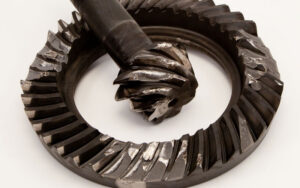While most race-related part breakage isn’t expected, it can be particularly distressing when one failure actually causes another. One of the most violent part failures a drag racer can experience is when a ring and pinion gives way, which occurs most often as the car leaves the starting line and the driveline is under tremendous load. In fact, if the ring and pinion teeth begin to shatter while the car is in low gear, it typically creates a severe pounding that travels through the driveline, and if the domestic three- or four-speed automatic that many cars employ is in place, the failure of the rear one-way roller clutch that resides within the transmission is often the result of “Cause and Effect”.

Not at all uncommon, roller clutch failure results in the need to replace not only the ring and pinion, but also the to remove and repair the automatic transmission, as well. Plenty of racers have replaced the ring and pinion only to find that the transmission had suffered damage from the resulting shock to the drivetrain. Ring and pinion failures are typically rooted in a gear set that has become fatigued and may have included small cracks, fractures, or even missing teeth, making it prone to an eventual, all-out failure.
Adding to the risk of gear failure are track conditions. If traction is optimal and the car is “hooking hard”, the driveline is certain to be under added stress. On the other hand, if track conditions are poor and the car encounters severe tire shake or chatter caused by the slicks hooking and then spinning in rapid succession, it causes severe loading and unloading of the driveline, which adds to the risk of a failure as well.
One-way roller clutches have been popularly used by auto makers in automatic transmissions since they are not only compact and durable but offer instant application. While a clutch pack or band in an automatic transmission is hydraulically activated, a roller clutch is mechanically activated and therefore offers quicker application. Although they are very durable in passenger car applications, one-way roller clutches can be a liability in racing applications. Many popular domestic automatics including the GM TH-350 and TH-400, Ford C-4 and C-6, and the Chrysler TF-727 and TF-904 utilize a one-way roller-type clutch. The TH-350 and TH-400 each feature two of the assemblies, one that is applied in manual low and another for second. Ironically, the only popular domestic automatic that lacks a roller clutch is the two-speed GM Aluminum Powerglide, yet one more reason that the unit is so prevalent in bracket racing applications where consistency and durability are crucial.
Regardless of make, the one-way clutch that resides within the transmission utilizes a series of rollers and springs in a specially-notched housing. While the inner race of the low/reverse roller clutch in a TH-350, for example, is smooth, the outer race is notched. The unit functions by allowing clockwise rotation of the inner race, yet instantly locks when turned counterclockwise as the springs force the rollers into the notched outer race. In the event that the transmission is subjected to a jaw-jarring ring and pinion failure, the races within the one-way roller clutch often fracture, sending a plethora of damaged rollers and springs throughout the transmission, requiring that the unit be completely stripped and thoroughly cleaned during repair.
While it’s highly recommended that any TF-727 racing transmission be fitted with an aftermarket, bolt-in style roller clutch (TCI127000) for safety reasons, there are no “bullet-proof” parts or absolute measures that can prevent breakage. There are practices, however, that should be avoided, such as changing from reverse to drive or vice versa without ensuring that the drive wheels have come to a complete stop, as well as manually downshifting into low gear with an open throttle. Additionally, any time the tires are spinning, such as when a racer is driving out of the water box, and suddenly gain enough traction to “chirp” the tires, it can potentially lead to roller clutch failure in not only the one-way clutch in the transmission, but also to the similar unit that is located within the torque converter.
Costly ring and pinion failures can be avoided by performing periodic ring and pinion inspection as a means of verifying gear condition and determining when gear replacement is needed, rather than waiting for an inevitable failure. If any teeth are found to be cracked, broken, or show excessive wear, the gear set should be replaced as soon as possible.
Gear choice is also an important consideration when maximum durability is a concern. While street/strip vehicles or mild drag cars are well suited to traditional 8620 steel gear sets, high-horsepower drag race-only cars should use what is referred to as a “pro” ring and pinion set. Manufactured from high-impact 9310 steel, “pro” gear sets are designed to endure the brutal launches associated with drag racing. The only drawback, however, is that the “softer” material requires more frequent replacement compared to their street gear counterparts. Richmond Gear, Motive Gear, and U.S. Gear offer a variety of ring and pinion sets for most popular rear ends.
A welcome addition to virtually any differential that features a rear cover are the heavy-duty units offered by Moser Engineering or Strange Engineering. The rigid aluminum covers feature special load bolts that butt up against the carrier bearing caps in an effort to increase rear end strength and help prevent ring and pinion failure. The covers are offered for a variety of popular GM, Ford, and Chrysler rears.
Although parts breakage seems to be an almost unavoidable part of racing, combining the benefits of proper gear selection with periodic inspections and other measures can help prevent a costly ring and pinion failure that often has the potential to lead to roller clutch failure, and potentially even more extensive transmission damage.